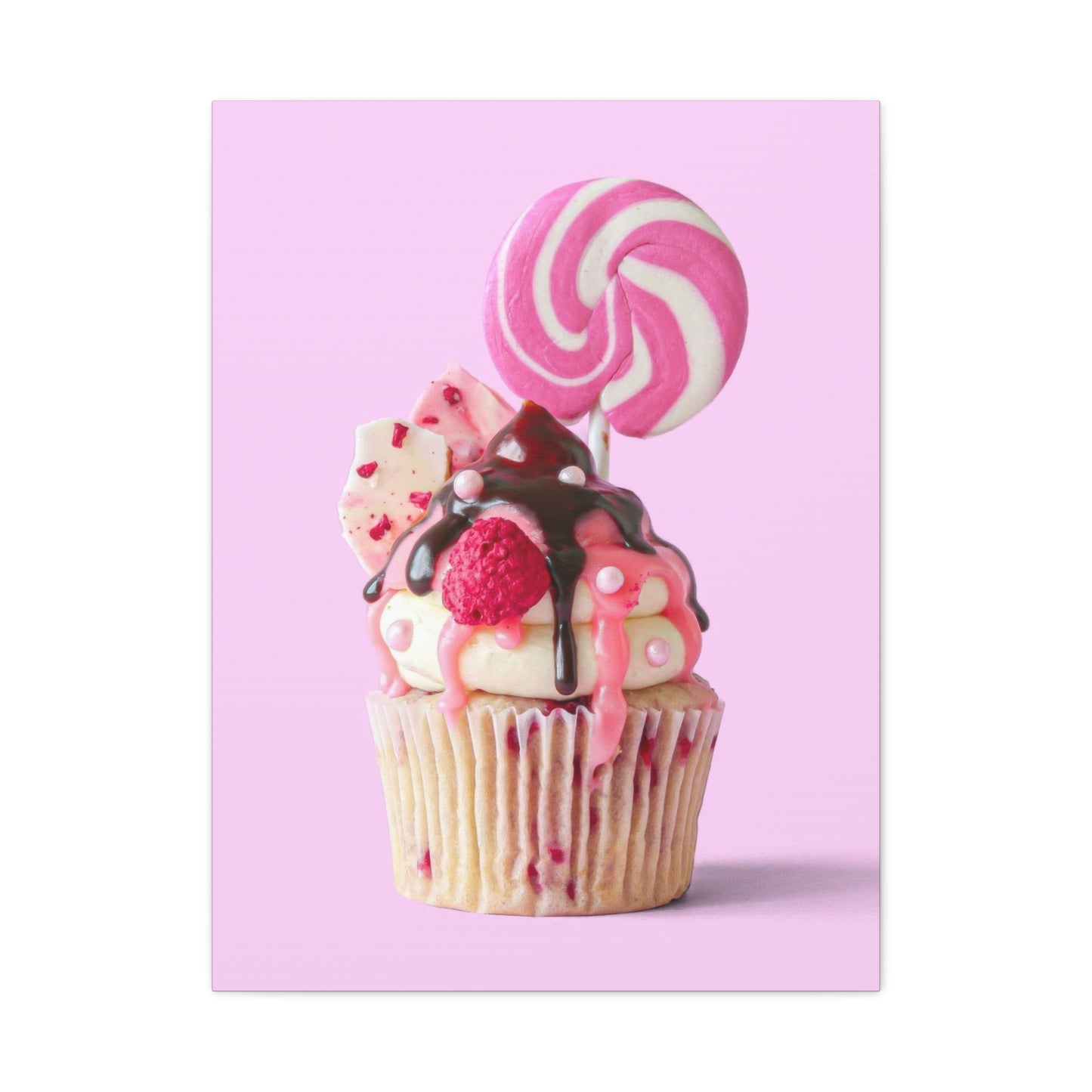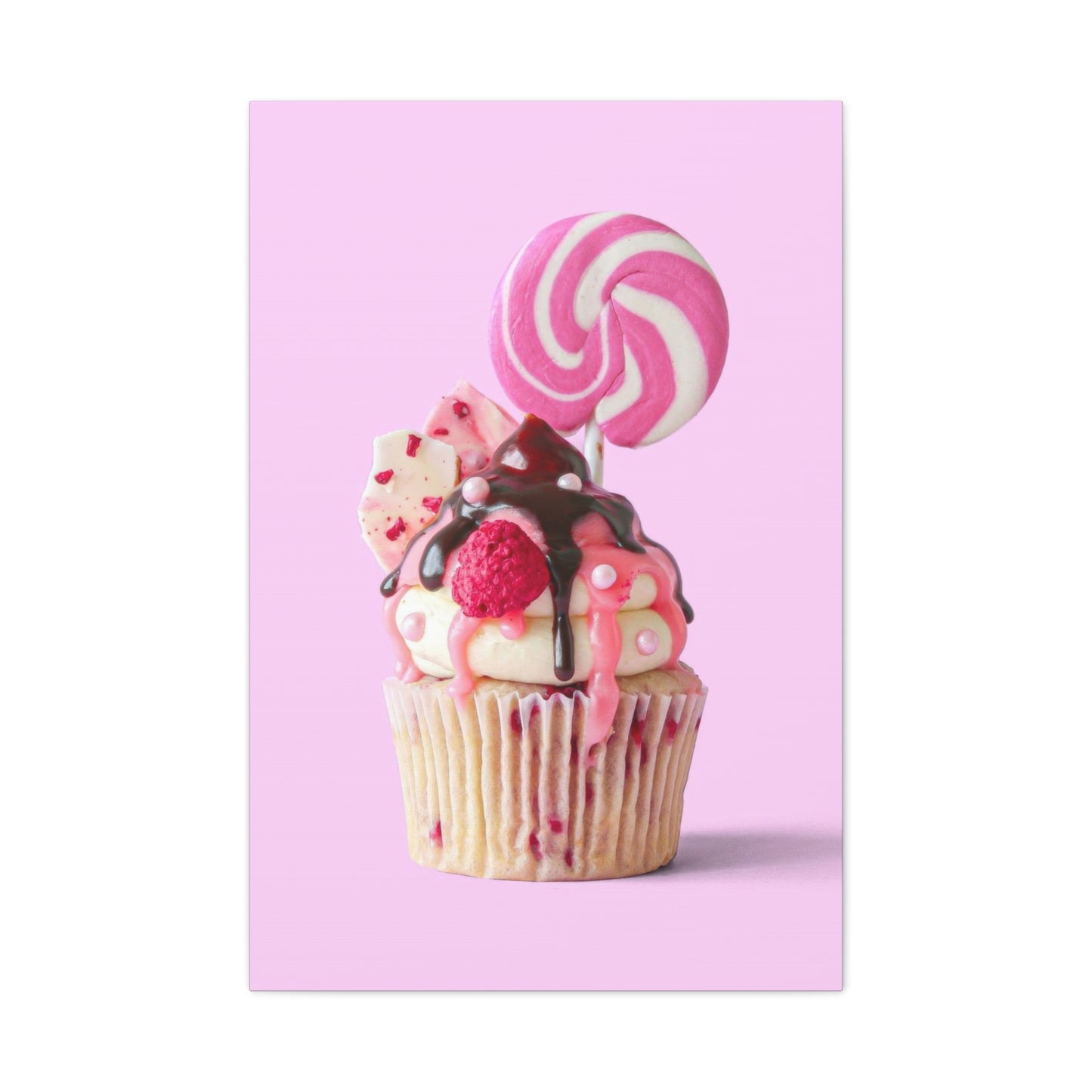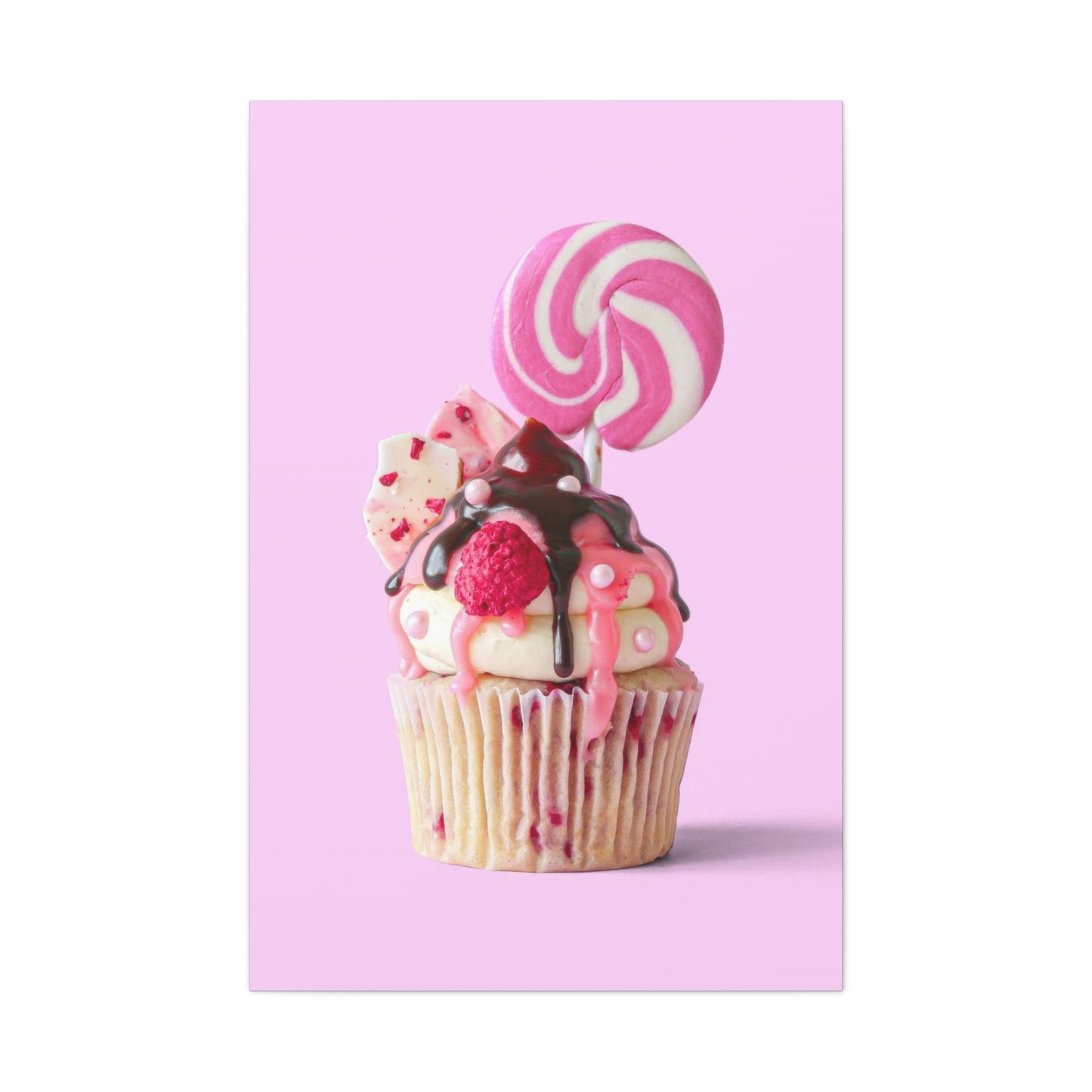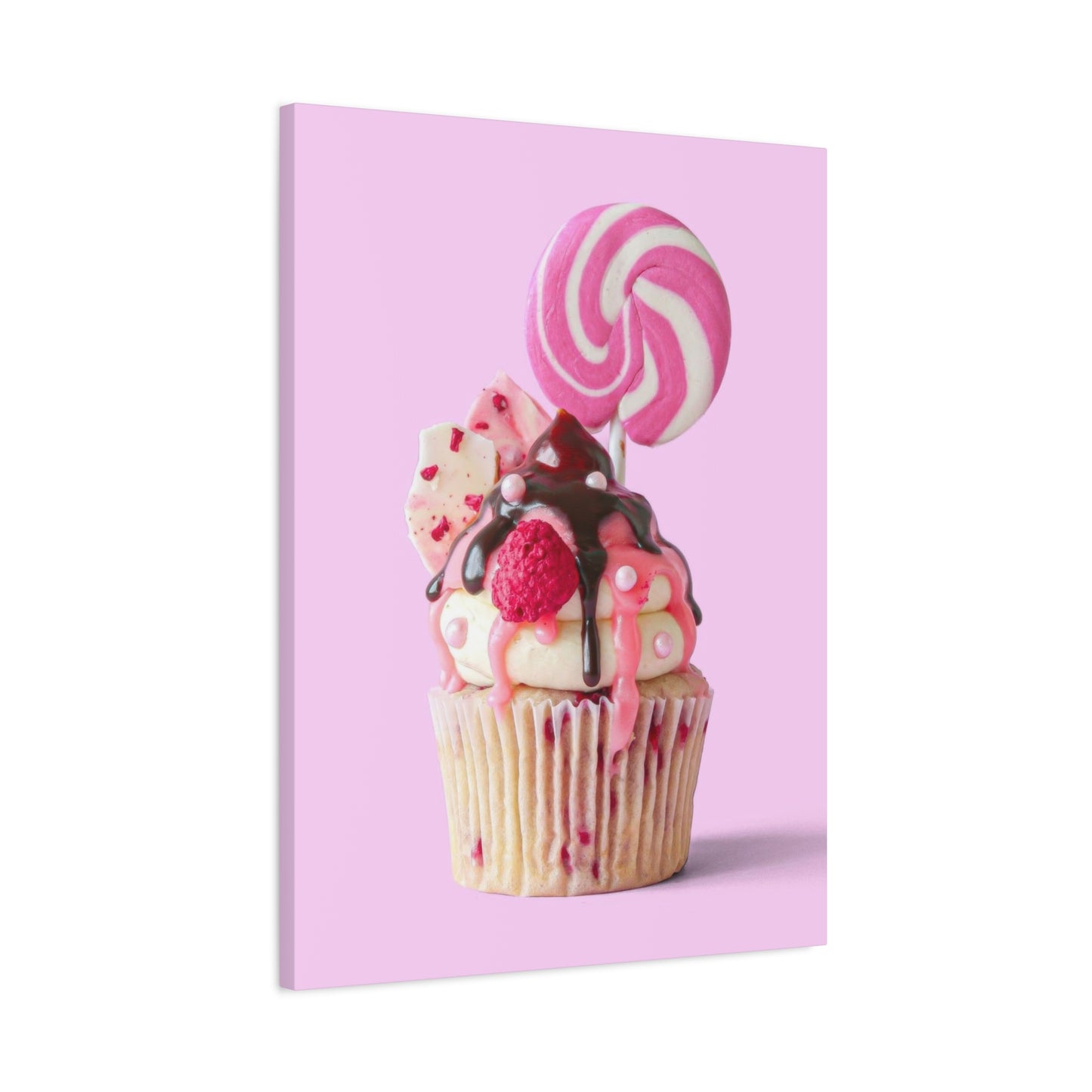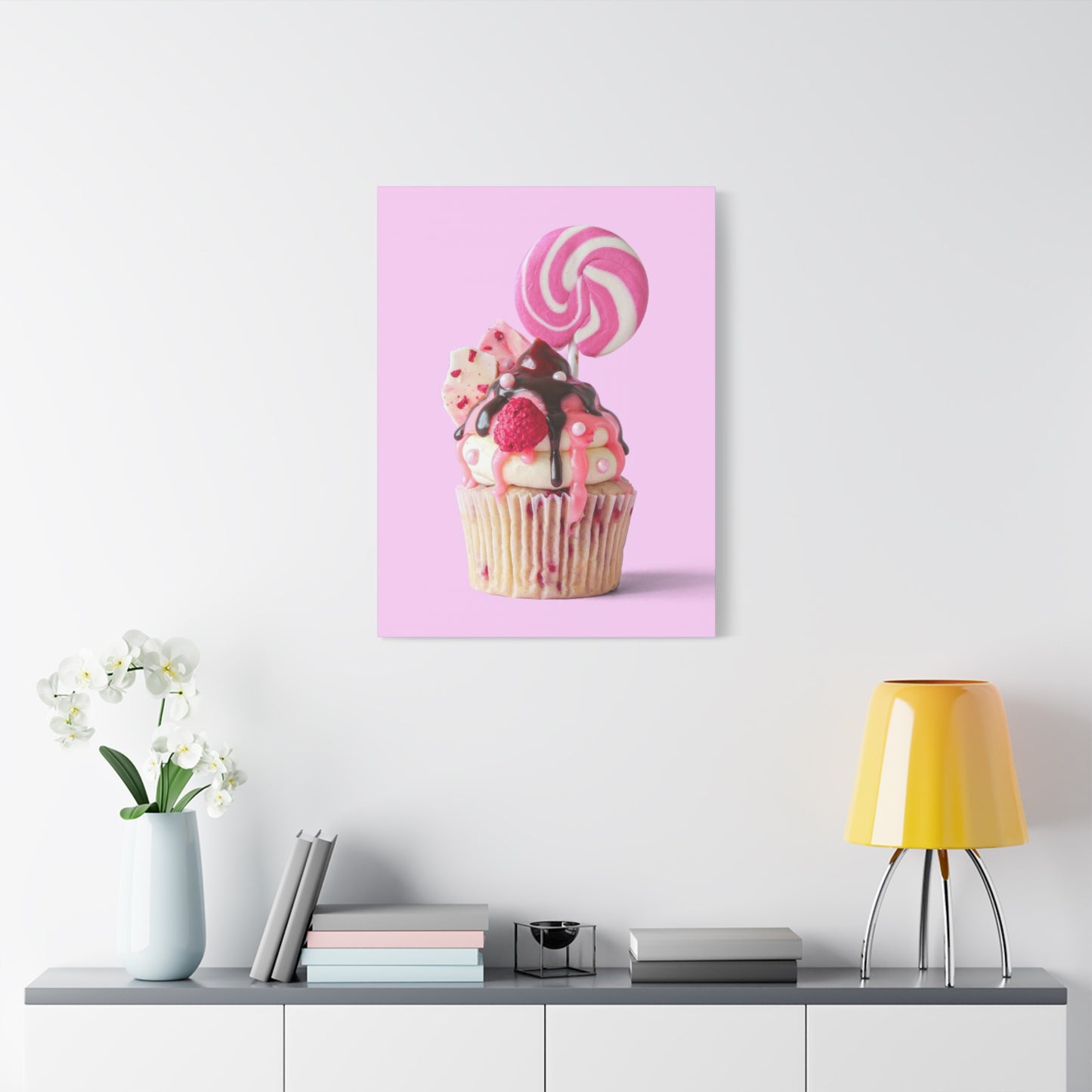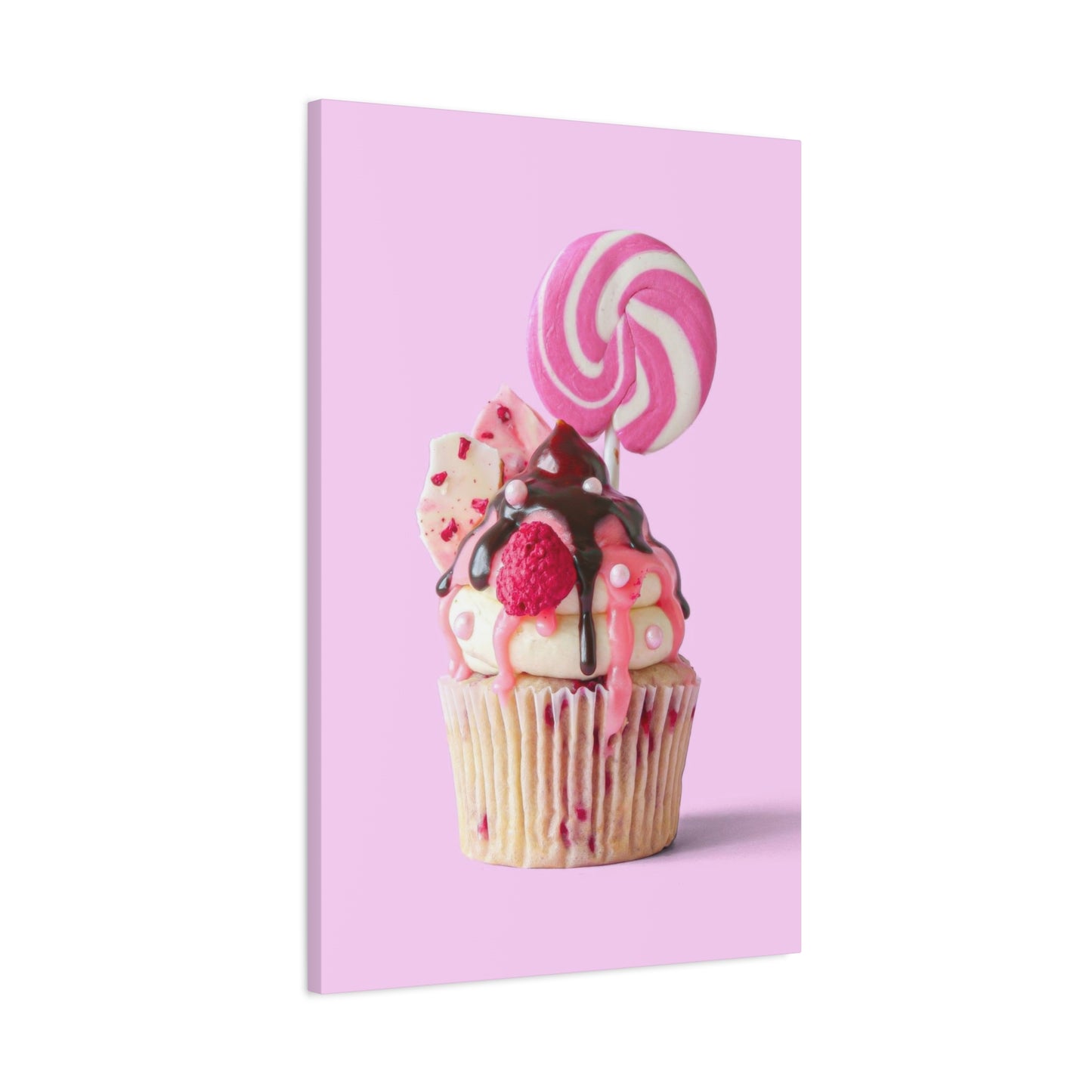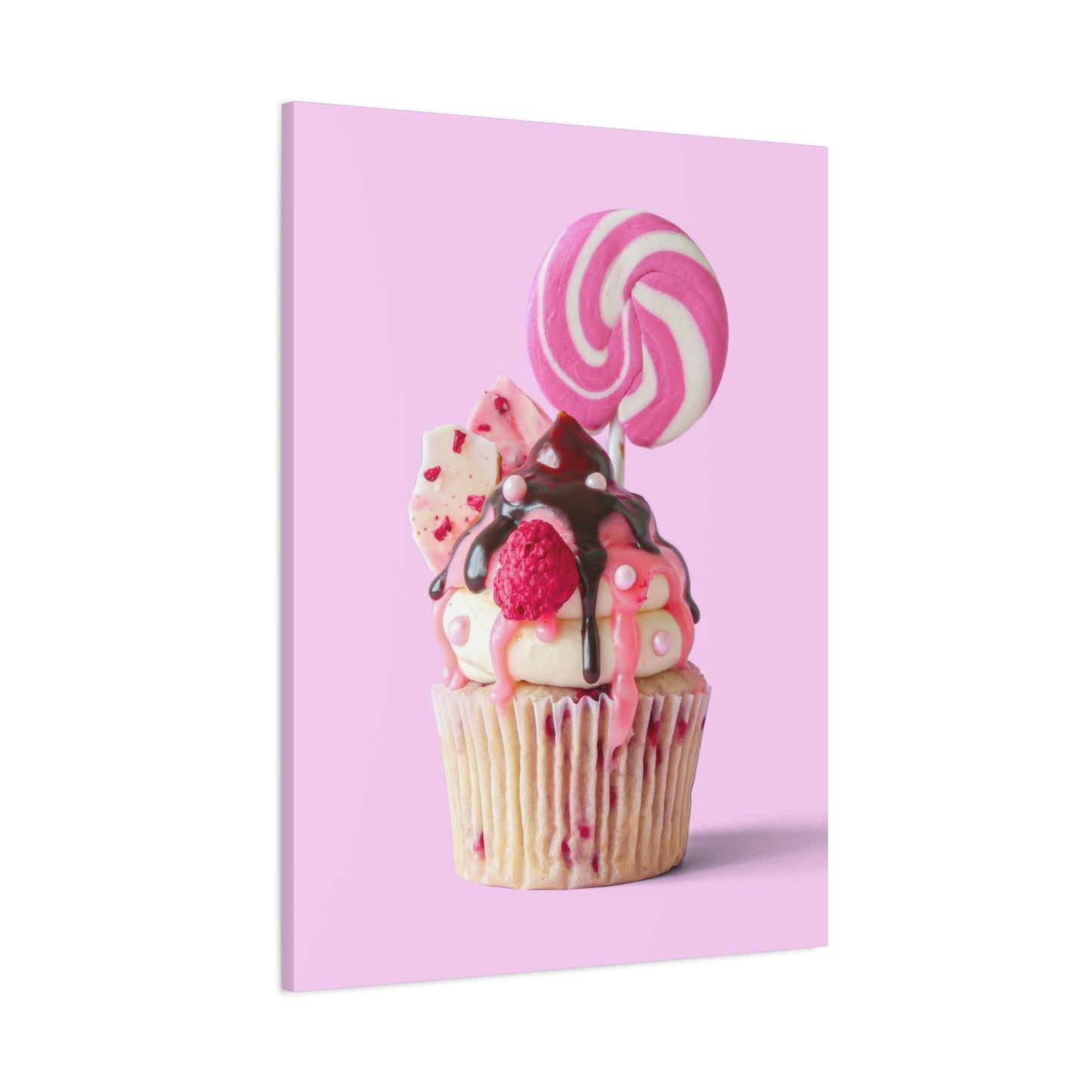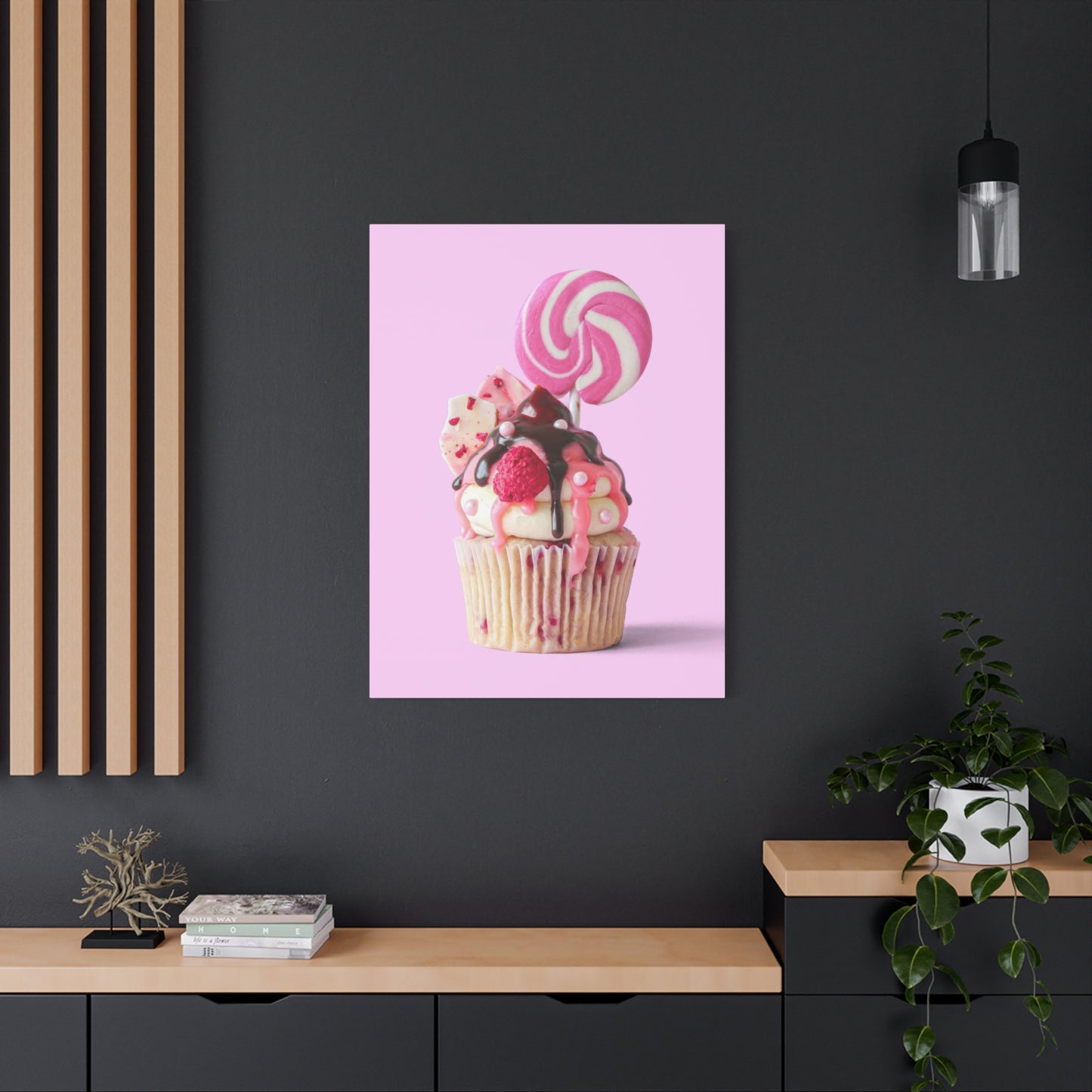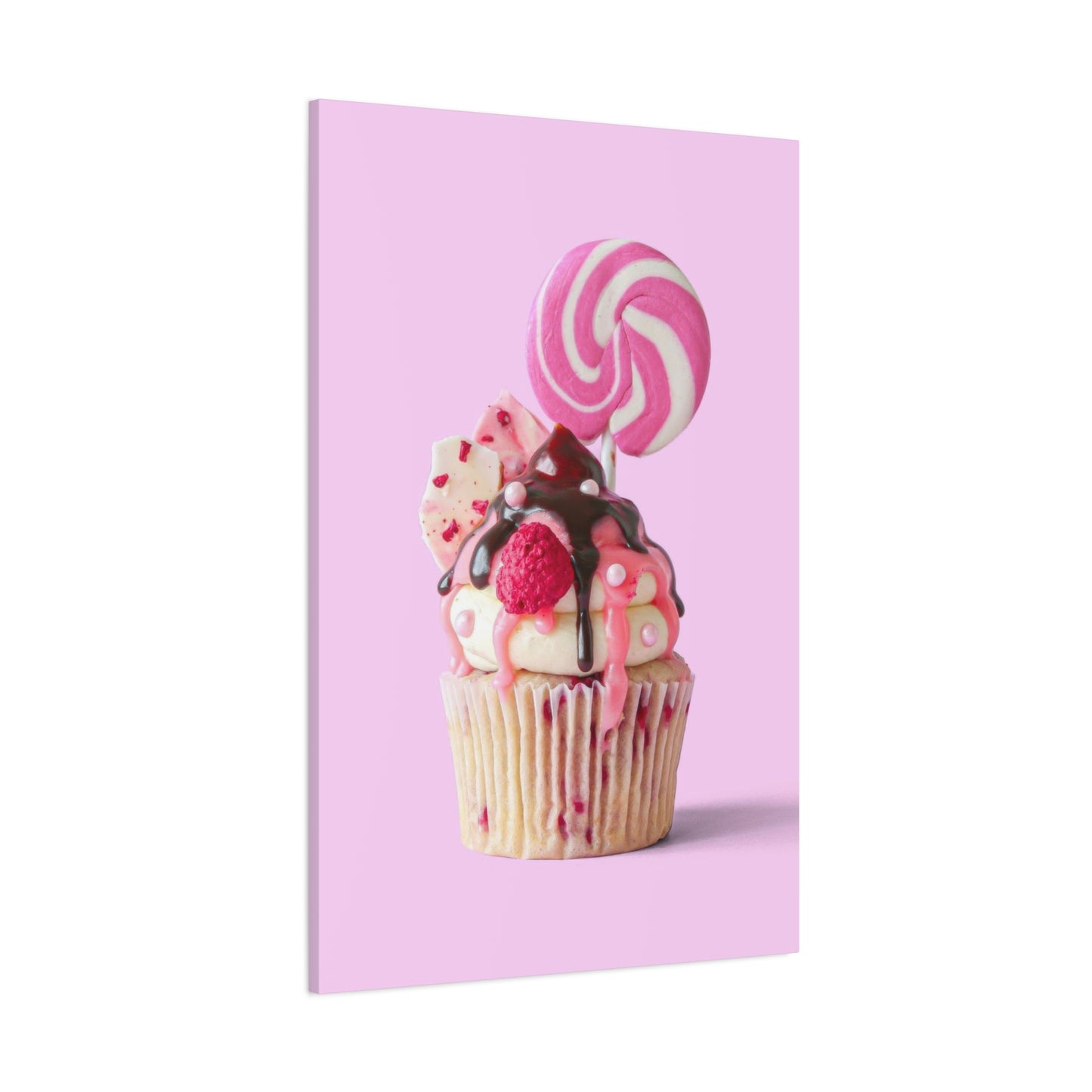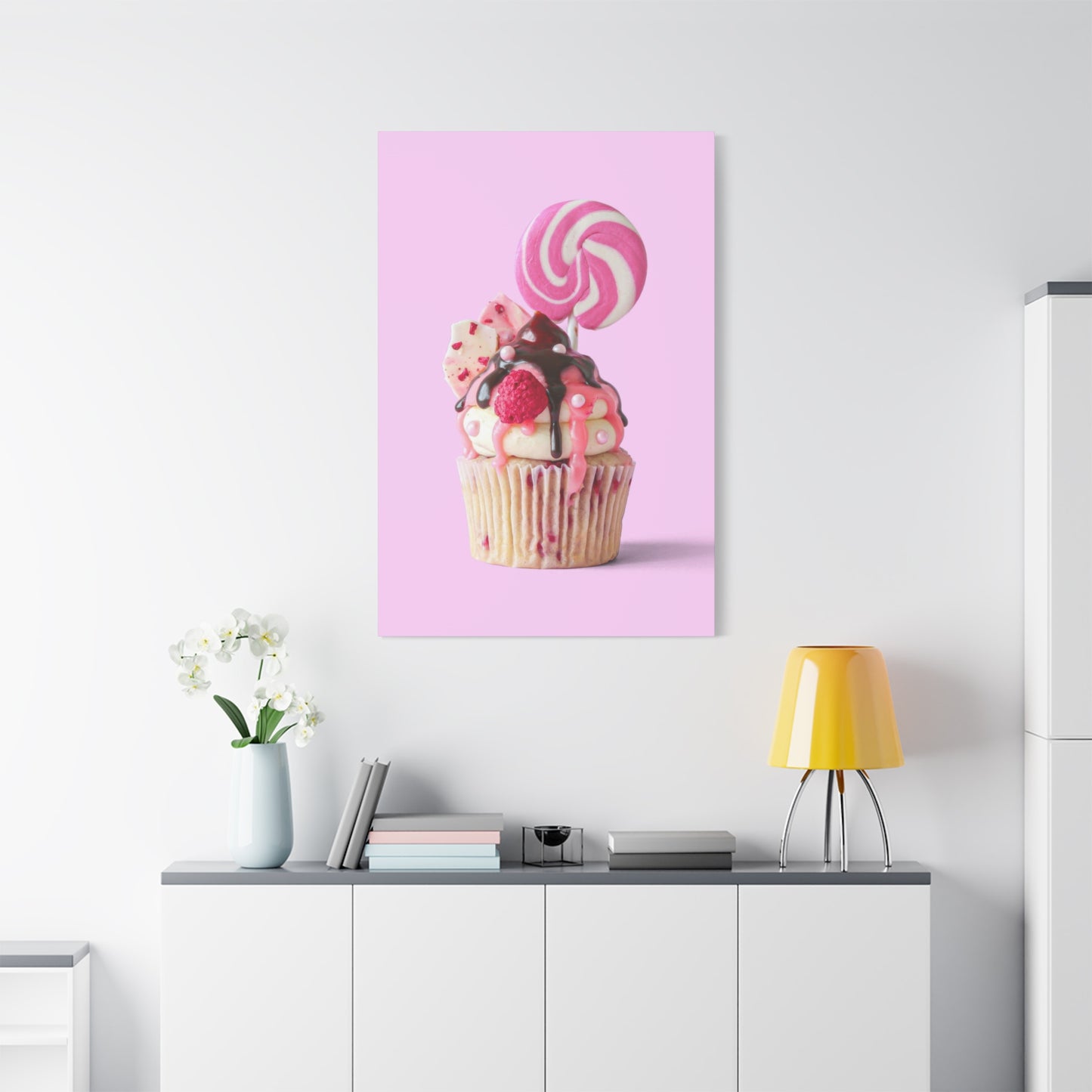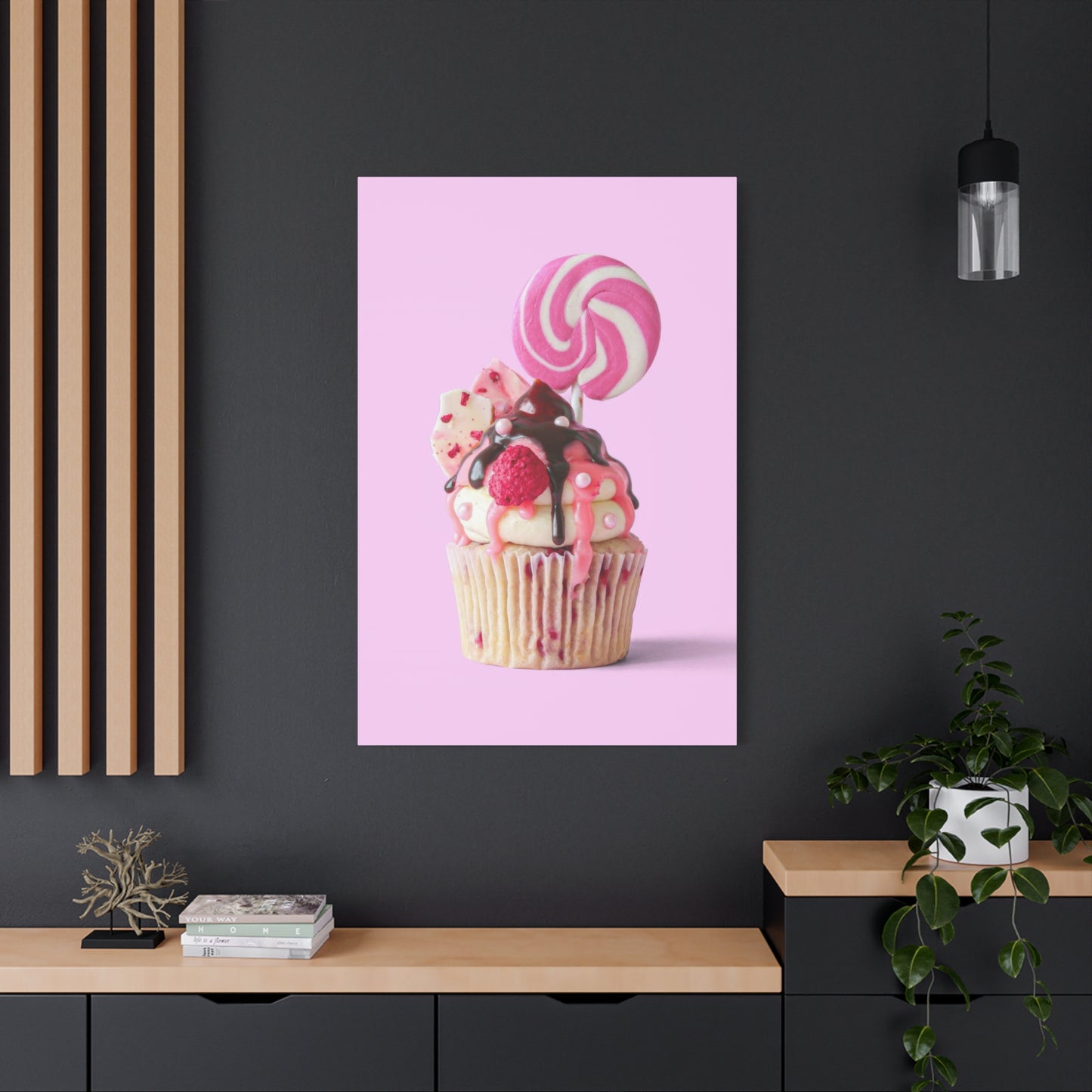The Sweet Escape: Exploring the Whimsical World of Candy Meadow Cupcake Wall Art
Creating a delightful and imaginative environment for children involves selecting decor that sparks joy and creativity. Dessert-inspired artwork featuring vibrant frosting, sprinkles, and charming treats can transform a child's bedroom into a magical sanctuary. These playful designs capture the innocence and wonder of childhood while providing visual stimulation that encourages imagination and happiness.
When selecting artwork for young ones, consider pieces that showcase bright colors and friendly designs. Frosted treats with smiling faces, rainbow sprinkles cascading down pastel backgrounds, and illustrated confections can create an atmosphere of warmth and comfort. The visual appeal of these sugary motifs resonates with children's natural attraction to colorful and cheerful imagery, making bedtime routines more enjoyable and creating a space they genuinely love spending time in.
Parents often find that dessert-themed decorations serve multiple purposes beyond mere aesthetics. These pieces can become conversation starters, teaching opportunities about colors and shapes, and even inspiration for creative play. A child who wakes up to walls adorned with cheerful baked goods imagery may feel more positive and energized to start their day. The psychological impact of surrounding children with uplifting visuals cannot be understated, as it contributes to their overall mood and emotional development.
The versatility of sweet-themed artwork allows it to grow with your child to some extent. While very young children appreciate the bright colors and simple shapes, older kids can develop a nostalgic attachment to these pieces that remind them of simpler times. Many teenagers even embrace dessert-inspired decor as part of a vintage or retro aesthetic, proving that these designs have staying power beyond the toddler years.
Candy-Meadow-Cupcake Art: A Sugar Rush for Your Walls
The fusion of candy motifs, meadow-fresh aesthetics, and delectable frosted treats creates an artistic style that delivers pure visual delight. This particular combination brings together the best elements of whimsy and natural beauty, resulting in artwork that feels both fantastical and grounded. The concept draws inspiration from imaginary landscapes where confections grow like flowers and sweetness permeates every corner of the scenery.
Artists working in this style often incorporate botanical elements alongside dessert imagery, creating surreal yet harmonious compositions. Picture lollipops standing tall like sunflowers in a field, frosted treats nestled among wildflowers, or candy-colored clouds drifting over meadows dotted with sugary delights. This artistic approach appeals to those who appreciate both the organic beauty of nature and the playful charm of confectionery design, bridging two worlds that might not typically intersect.
The color palettes employed in candy-meadow-cupcake artwork tend toward pastels and bright hues that evoke both natural settings and sweet shop displays. Soft pinks blend with mint greens, lavender mixes with buttery yellows, and sky blues complement peachy tones. These color combinations create spaces that feel fresh, airy, and undeniably cheerful. The strategic use of white space or cream backgrounds allows the vibrant elements to pop without overwhelming the viewer, maintaining a sense of balance and sophistication despite the playful subject matter.
Textural elements play a significant role in this artistic style. Many pieces incorporate visual representations of frosting swirls, sprinkle textures, grass blades, and flower petals that add depth and interest to the compositions. Whether rendered in smooth digital graphics, watercolor washes, or mixed media approaches, these textural details invite closer inspection and create artwork that rewards repeated viewing. The interplay between smooth frosting surfaces and organic meadow elements provides visual contrast that keeps the eye moving throughout the piece.
This style particularly shines in spaces that embrace eclectic or maximalist design philosophies. The unexpected combination of elements encourages creativity and shows that home decor doesn't need to follow strict rules or traditional categories. By placing candy-meadow-cupcake artwork in your space, you make a statement about valuing joy, imagination, and the freedom to blend influences in unexpected ways. This artistic approach celebrates the idea that our environments should reflect our personalities and bring us happiness, regardless of conventional design wisdom.
How Cupcake Wall Art Adds Fun to Any Room
Incorporating frosted treat imagery into your living spaces introduces an element of playfulness that can transform the entire atmosphere. These cheerful designs possess an inherent lightheartedness that counterbalances the seriousness of everyday life. After a long day dealing with responsibilities and stress, returning home to walls adorned with whimsical dessert imagery can provide instant mood elevation and create a sense of escape from external pressures.
The visual language of baked goods speaks to universal experiences of celebration, indulgence, and comfort. Birthdays, weddings, afternoon tea parties, and countless happy occasions feature these treats prominently, so our brains naturally associate their imagery with positive emotions and memories. By bringing these symbols into our daily environments, we tap into those positive associations without needing actual sweets present. The psychological impact works on a subconscious level, creating ambient happiness that influences our mood throughout the day.
Functionally, dessert-inspired artwork serves as excellent conversation pieces that help break the ice with guests. Visitors often comment on unexpected or playful decor choices, providing natural openings for discussions about personal style, artistic preferences, or shared childhood memories. These interactions help create warmer social atmospheres in your home, making guests feel more comfortable and welcomed. The approachable nature of the imagery puts people at ease compared to more serious or abstract art that might feel intimidating or pretentious.
The versatility of frosted treat artwork allows it to work in various design contexts. In minimalist spaces, a single statement piece featuring a beautifully rendered baked good can serve as the room's focal point, adding personality without cluttering the aesthetic. In more eclectic or maximalist environments, multiple dessert-themed pieces can be combined with other artwork to create rich, layered gallery walls that reflect diverse interests and influences. The imagery scales effectively from small accent pieces to large format prints that dominate entire walls.
Colorful Candy-Themed Wall Art for Bright Spaces
When your goal is creating an energetic, vibrant environment, candy-inspired artwork delivers unmatched visual impact. These pieces typically feature bold, saturated colors that command attention and infuse spaces with dynamism and life. The rainbow hues commonly found in confectionery designs translate beautifully to wall art, offering opportunities to incorporate multiple colors simultaneously without creating visual chaos, thanks to the cohesive theme that ties diverse shades together.
Bright spaces benefit tremendously from artwork that embraces rather than fights their luminous quality. Rooms with abundant natural light can sometimes feel sterile or washed out with too much white or pale decor. Candy-themed pieces introduce necessary color saturation that grounds these spaces and gives the eye interesting places to rest. The reflective quality of well-lit rooms actually enhances the vibrancy of colorful artwork, making the hues appear even more brilliant and alive throughout different times of day as natural light shifts.
The psychological effects of color are well-documented, and candy-themed artwork allows you to strategically incorporate hues known to boost mood and energy. Yellows promote happiness and creativity, oranges encourage enthusiasm and warmth, reds stimulate excitement and passion, and blues create feelings of calm and serenity. By selecting candy artwork that emphasizes particular colors, you can subtly influence the emotional atmosphere of your space. Mixed candy compositions offer balanced color exposure that provides varied psychological benefits simultaneously.
Installation approaches for candy-themed artwork in bright spaces require some consideration. Direct sunlight can fade certain print types over time, so understanding your artwork's materials and using UV-protective glass or coatings helps preserve color vibrancy. Placement on walls perpendicular to windows rather than directly opposite them can reduce fading while still allowing the artwork to benefit from ambient light. For rooms with variable lighting, consider how the piece appears during different times of day and under artificial lighting to ensure consistent appeal.
Cupcake-Inspired Art for a Whimsical Home
Embracing whimsy in home design means rejecting overly serious aesthetics in favor of charm, imagination, and personal expression. Frosted treat imagery embodies this philosophy perfectly, offering sophisticated artwork that doesn't take itself too seriously. A whimsical home feels collected rather than decorated, personal rather than staged, and these dessert-inspired pieces contribute to that authentic, lived-in atmosphere that makes spaces truly feel like home rather than showrooms.
The architectural details of baked goods provide rich visual interest that translates beautifully to artistic representation. Swirled frosting creates organic, flowing lines that please the eye and add movement to static walls. Layered components offer opportunities for color blocking and pattern play. Decorative toppings introduce textural variety and small-scale details that reward close examination. Artists can emphasize different aspects depending on their style, resulting in endless variations on the theme from photorealistic renderings to abstract interpretations.
Creating a cohesive whimsical aesthetic involves balancing playful elements with grounding components. Dessert artwork pairs beautifully with natural materials like wood, rattan, and linen that provide textural contrast and prevent the space from feeling too juvenile or theme-heavy. Vintage furniture pieces gain new life when paired with contemporary frosted treat prints, creating interesting temporal juxtapositions that add depth to your design story. The key is mixing high and low, serious and playful, old and new in ways that feel intentional rather than haphazard.
Seasonal rotation of dessert-themed artwork offers opportunities to refresh your space without major investments. Spring might feature pieces with pastel frostings and floral garnishes, summer could showcase bright sorbet colors and fruit-topped creations, autumn welcomes spice cake hues and harvest decorations, and winter embraces peppermint themes and holiday treats. This approach keeps your environment dynamic and prevents design fatigue while maintaining the overall whimsical aesthetic you've cultivated throughout the year.
DIY Cupcake Wall Art: Easy Ideas for Sweet Decor
Creating your own dessert-inspired artwork offers satisfaction beyond simply purchasing finished pieces. The process of making something with your hands provides therapeutic benefits while resulting in truly unique decor that perfectly matches your vision and space. Even those without extensive artistic training can produce charming frosted treat artwork using accessible techniques and materials available at craft stores or online retailers.
Watercolor techniques work beautifully for dessert subjects because the medium's soft, flowing nature mimics the smooth texture of frosting and creates appealingly soft edges. Begin with light pencil sketches of basic treat shapes, then layer watercolor washes to build up color and depth. The imperfect, organic quality of watercolor suits dessert subjects particularly well, as slight variations and happy accidents often enhance rather than detract from the final piece. Allowing colors to blend naturally on the paper creates interesting gradients reminiscent of marbled frostings or ombre designs.
Collage approaches offer another accessible entry point for DIY dessert artwork. Gather scrapbook papers, fabric scraps, magazine cutouts, or other decorative papers in appropriate colors and patterns. Cut or tear these materials into shapes representing different treat components, then arrange and adhere them to your base surface. This technique produces artwork with wonderful textural variety and dimensional interest. Younger family members can easily participate in collage projects, making this an excellent approach for collaborative pieces that everyone contributed to creating.
Acrylic paint provides bold, opaque coverage perfect for graphic dessert designs. Create simple template shapes using cardboard or thick paper, then use these guides to paint clean-edged treats on your canvas or board. Layering different colors and adding details with smaller brushes or paint pens can create surprisingly sophisticated results. The quick drying time of acrylics allows for efficient work sessions and easy correction of mistakes by simply painting over areas that don't work out as planned.
Digital creation has become increasingly accessible with free or affordable design software and apps. Those comfortable with technology can design dessert artwork on tablets or computers, then print the results at home or through professional printing services. This approach offers infinite possibilities for revision and experimentation without wasting physical materials. Digital artwork can be easily resized to fit different spaces, and you can produce multiple copies to create coordinated sets or gift identical pieces to friends and family members.
Playful Cupcake Art for Modern Kitchens
Modern kitchen design often emphasizes clean lines, minimalist aesthetics, and functional beauty. Introducing dessert-themed artwork into these spaces might seem counterintuitive, but the right pieces can actually enhance contemporary kitchen design while adding necessary warmth and personality. The key lies in selecting artwork that embraces modern artistic techniques while celebrating the subject matter's inherent charm and appeal.
Graphic, stylized representations of baked treats work particularly well in modern kitchens. Think bold line drawings, pop art-inspired compositions, or minimalist illustrations that reduce treats to their essential shapes and colors. These approaches honor contemporary design sensibilities while introducing the playful element that prevents spaces from feeling cold or sterile. Black and white dessert illustrations provide particularly striking options for monochromatic kitchens, adding visual interest without disrupting carefully planned color schemes.
The thematic appropriateness of dessert artwork in kitchens creates natural cohesion between decor and function. Unlike abstract pieces that might feel randomly placed, baked goods imagery makes immediate sense in spaces dedicated to food preparation and consumption. This logical connection between subject and setting creates a sense of intentionality in your design choices, demonstrating thoughtfulness rather than arbitrary decoration decisions.
Scale considerations become especially important in kitchens where wall space often competes with cabinetry, appliances, and functional elements. Larger statement pieces work well in dining areas or on walls opposite work zones where they can be appreciated without interfering with activities. Smaller coordinating pieces can be arranged on narrow walls between windows or above doorways, making use of otherwise awkward spaces. Consider the sightlines from various positions in the kitchen to ensure artwork is visible from where people actually spend time rather than hidden in corners no one looks toward.
Material selections for kitchen artwork require extra consideration due to humidity, temperature fluctuations, and potential exposure to cooking splatter. Glass-fronted frames protect prints from moisture and allow for easy cleaning with glass cleaner. Metal prints offer a contemporary look while providing natural protection against environmental factors. Canvas prints should be sealed with protective coatings if they'll be in high-exposure areas. Positioning artwork away from stoves and sinks reduces risk while still allowing the pieces to contribute to the overall design.
The color psychology of dessert imagery can influence appetite and mood in dining spaces. Warm colors like reds, oranges, and yellows traditionally stimulate appetite and create inviting atmospheres perfect for gathering spaces. Cooler tones like blues and purples have calming effects that might encourage more mindful eating. Consider the atmosphere you want to create in your kitchen and select dessert artwork with color palettes that support those goals, using the imagery as both decoration and subtle psychological influence.
Sweeten Your Office with Cupcake Wall Art
Office environments, whether home-based or corporate, traditionally lean toward serious, professional aesthetics that sometimes sacrifice comfort and personality in pursuit of credibility. However, the rise of creative industries and changing attitudes toward workplace environments have made playful decor increasingly acceptable and even desirable. Dessert-themed artwork in offices makes powerful statements about company culture, personal values, and the belief that work and enjoyment need not be mutually exclusive.
The psychological benefits of cheerful imagery in work environments are substantial and documented. Studies consistently show that positive visual stimuli improve mood, which correlates with increased productivity, better problem-solving abilities, and enhanced creativity. Workers who personalize their spaces with meaningful decor report higher job satisfaction and stronger connections to their work environments. A well-chosen piece of frosted treat artwork can serve as a visual reminder not to take things too seriously, helping prevent burnout and maintaining perspective during stressful periods.
Personal offices allow for greater expression than shared workspaces, making them ideal for dessert-themed pieces that reflect individual personality. A home office particularly benefits from decor that bridges the professional and personal, creating spaces that support work while acknowledging the domestic setting. Frosted treat artwork achieves this balance beautifully, appearing professional enough for video call backgrounds while adding sufficient personality to prevent the space from feeling corporate or impersonal.
In client-facing environments, dessert artwork can strategically communicate values and brand personality. Creative agencies, boutique consultancies, and lifestyle brands particularly benefit from decor choices that demonstrate their innovative thinking and human-centered approaches. The juxtaposition of professional services and whimsical imagery creates memorable experiences that distinguish your office from competitors. Clients remember spaces that made them feel comfortable and smiled, creating positive associations with your brand beyond the services you provide.
The Charm of Candy-Themed Wall Art
The enduring appeal of confectionery imagery transcends age, culture, and design trend cycles. This universal charm stems from deep psychological associations formed during childhood and reinforced throughout life. Sweets represent rewards, celebrations, indulgence, and freedom from restriction. Even those who no longer regularly consume confections retain positive associations with candy imagery, making it one of the most reliably mood-boosting visual themes available to decorators.
The diversity within candy-themed artwork prevents monotony and allows for sophisticated expression. Vintage candy shop aesthetics evoke nostalgia and simpler times, rendered in muted tones and retro graphics. Contemporary candy art might embrace bold colors and graphic design principles for modern impact. Artistic interpretations can range from photorealistic to abstract, from literal to symbolic. This range means that candy imagery can be adapted to virtually any design style, from traditional to cutting-edge contemporary.
The symbolic meanings attached to different candy types add layers of interest to themed artwork. Lollipops suggest childhood innocence and simple pleasures. Chocolate imagery carries connotations of luxury and indulgence. Hard candies might evoke grandparent's houses and old-fashioned charm. Gummy candies communicate playfulness and fun. Selecting candy artwork based on these subtle associations allows you to communicate specific feelings and memories through your decor choices beyond just the visual appeal.
The glossy, reflective quality of many candies creates interesting artistic challenges and opportunities. Artists must capture the way light plays across smooth surfaces, creates highlights and shadows, and makes colors appear to glow from within. Successfully rendered candy artwork possesses a luminous quality that draws the eye and creates focal points in rooms. This play of light becomes particularly interesting in prints and paintings where artists must use technique and color theory to suggest transparency and shine without actual reflective surfaces.
Candy-themed collections allow for creative curation and display strategies. Rather than single statement pieces, consider creating gallery walls that tell stories or explore themes. A collection might trace the history of a particular candy type, showcase candies from around the world, or present various artistic interpretations of similar subjects. The collecting process itself becomes an enjoyable hobby, with the search for new pieces adding excitement and giving purpose to visits to art fairs, galleries, or online marketplaces.
Cupcake Wall Art as a Perfect Gift Idea
Selecting meaningful gifts requires understanding recipients' tastes while finding items that feel special rather than generic. Dessert-themed artwork offers unique advantages as gift choices, combining universal appeal with opportunities for personalization and thoughtfulness. The inherent cheerfulness of these pieces makes them appropriate for various occasions while remaining substantial enough to feel like genuine investments rather than throwaway purchases.
Birthday gifts naturally align with frosted treat imagery given the strong cultural association between celebrations and desserts. Artwork depicting elaborately decorated baked goods makes perfect sense for birthday presents, creating visual reminders of the special day long after the actual treats have been consumed. This symbolic connection adds meaning beyond the artwork's aesthetic value, transforming it from mere decoration into a memento of celebration and affection.
Housewarming presents should help recipients personalize new spaces and create homey atmospheres. Dessert artwork serves this purpose beautifully by immediately adding warmth and personality to bare walls. Unlike furniture or functional items that might not suit the recipient's existing possessions or needs, artwork can adapt to various rooms and design schemes. The relatively lightweight nature of framed prints also makes them easy to transport and install without requiring professional help or special equipment.
Wedding and anniversary gifts traditionally commemorate relationships and shared experiences. Frosted treat artwork can reference the couple's wedding cake, favorite desserts, or simply represent the sweetness of their relationship through visual metaphor. Commissioning custom pieces that incorporate specific details meaningful to the couple elevates the gift from pretty to profoundly personal, creating treasured keepsakes that tell their unique story.
Holiday gift-giving takes on special character with seasonally appropriate dessert artwork. Winter celebrations might inspire pieces featuring peppermint, gingerbread, or holiday-themed treats. Spring could bring pastel-frosted goods adorned with flowers. Summer suggests fruit-topped creations and bright sorbet colors. Autumn welcomes spice cake hues and harvest themes. These seasonal variations allow you to give dessert artwork multiple times to the same person without repetition, building a collection they can rotate throughout the year.
Top Candy-Meadow-Cupcake Art Picks for Your Home
Selecting the perfect pieces for your space requires understanding what qualities make dessert artwork successful and how different styles serve various functions and aesthetics. While personal taste ultimately determines what works for individual homes, certain characteristics consistently produce satisfying results across different settings and design approaches.
Large-scale pieces with bold, simple compositions create striking focal points in living rooms, bedrooms, or dining areas. These statement works should be sophisticated enough to anchor adult spaces while maintaining the playful spirit that makes dessert imagery appealing. Look for pieces that use negative space effectively, preventing the composition from feeling cluttered despite potentially complex subject matter. Color palettes that include both saturated hues and neutral tones allow the artwork to make an impact while remaining versatile enough to work with evolving decor schemes.
Series or sets of coordinating smaller pieces offer flexibility in arrangement and allow for creative expression through layout choices. Triptychs depicting different desserts or candy types in consistent styles create cohesive narratives across wall space. These coordinated collections work beautifully in hallways, staircases, or above furniture where a single large piece might feel too heavy or overwhelming. The ability to separate the pieces across different rooms also allows one purchase to impact multiple spaces.
Textured or dimensional pieces add sculptural interest beyond flat prints or paintings. Look for artwork incorporating fabric elements, paper layering, or other materials that create physical depth and cast shadows. These pieces change appearance throughout the day as lighting shifts, creating dynamic displays that reward repeated viewing. The tactile quality also invites closer inspection, turning wall art into conversation pieces that guests want to examine more carefully.
Limited edition prints or original works from emerging artists represent investments that appreciate in value while providing aesthetic pleasure. Supporting working artists adds meaning to your purchase beyond the object itself, and many artists welcome commissions for custom pieces tailored to your specifications. Original artwork carries unique energy and authenticity that mass-produced prints cannot replicate, making your home feel more curated and personal.
Cupcake Art: A Fun Way to Brighten Up Your Space
Transforming living environments from merely functional to genuinely uplifting requires intentional choices about the elements we introduce. Frosted treat artwork serves as powerful mood elevation tools that work through multiple psychological mechanisms to create happier, more inviting spaces. The visual impact combines with symbolic associations and personal connections to produce effects far beyond simple decoration.
The science of color psychology explains much of dessert artwork's mood-boosting power. The pastel pinks, blues, yellows, and lavenders common in frosted treat imagery are proven to reduce stress and anxiety while promoting feelings of calm and contentment. These soft hues feel nurturing and comforting, creating environments that feel safe and welcoming. Brighter, more saturated colors like those found in candy-themed pieces stimulate mental activity and energy, making them perfect for spaces where you want to feel alert and engaged.
The shapes and lines within dessert artwork also contribute to its psychological impact. The rounded, organic forms of treats lack threatening angles or aggressive geometry, instead presenting soft, approachable shapes that put viewers at ease. Swirled frosting creates visual movement that guides the eye in pleasing patterns, while balanced compositions provide satisfying symmetry that humans find inherently appealing. Even asymmetrical pieces typically maintain overall balance that feels dynamic rather than chaotic.
Personal memories associated with desserts amplify artwork's emotional impact. Most people carry positive memories of birthday cakes, special treats from grandparents, or celebrations marked by particular sweets. Artwork depicting similar items triggers these memory associations, bringing the positive emotions attached to those experiences into the present moment. This psychological connection operates largely on subconscious levels, creating ambient positive feelings without requiring conscious reflection on why particular pieces affect us.
The act of choosing dessert artwork itself represents a form of self-care and life affirmation. Selecting decor purely for joy rather than prestige, investment value, or others' approval demonstrates healthy prioritization of personal happiness and mental wellbeing. Surrounding yourself with images that make you smile acknowledges that your environment affects your quality of life and that you deserve to live in spaces that support rather than drain your emotional energy.
Candy-Meadow-Cupcake Art for Special Occasions
Special events and celebrations call for decorations that enhance the festive atmosphere and create memorable environments. Dessert-themed artwork serves these purposes beautifully while offering advantages over disposable decorations that must be discarded after single uses. Investing in quality pieces that suit special occasions creates sustainable celebration tools that can be used repeatedly while contributing to everyday decor between events.
Birthday celebrations gain extra sweetness from frosted treat artwork that reinforces the festive mood. Creating special gallery walls that come out only for birthday months makes the celebration feel extended beyond single days. Children particularly enjoy seeing their rooms transformed with extra decorations, and artwork provides this transformation without the waste of balloons and paper decorations. The pieces become part of birthday traditions, with children anticipating their appearance as part of what makes their birthday special.
Baby showers and nursery decorating benefit enormously from gentle dessert imagery that creates sweet, nurturing environments. Pastel-frosted treats and soft candy colors provide perfect palettes for these occasions, communicating tenderness and care appropriate to celebrating new life. Unlike explicitly baby-themed decorations that become dated as children grow, dessert artwork can transition with children through various developmental stages, eventually moving to playrooms or other spaces rather than becoming obsolete.
Wedding celebrations and receptions can incorporate dessert artwork in creative ways that enhance the aesthetic while remaining budget-conscious. Displaying dessert-themed pieces at the venue creates Instagram-worthy backdrops for photos that guests will cherish and share. The artwork can reference the couple's cake design or simply reinforce the sweet, celebratory atmosphere. After the event, the pieces move into the couple's home as lasting reminders of their special day that continue providing value for years.
Holiday celebrations throughout the year find perfect partners in seasonally appropriate dessert artwork. Rotating displays of gingerbread and peppermint treats for winter holidays, pastel eggs and spring confections for Easter, patriotic candy colors for summer celebrations, and autumn spice treats for fall gatherings create festive atmospheres that feel intentional and curated. These pieces can be stored between uses and brought out year after year, building traditions and nostalgic connections that deepen over time.
Anniversary celebrations marking relationship milestones gain symbolic depth from dessert imagery that represents the sweetness shared between partners. Couples can exchange dessert artwork as anniversary gifts, building collections that chronicle their years together. Each piece becomes a chapter in their ongoing story, with the accumulating display serving as visual testament to enduring love and shared experiences. The practice transforms ordinary anniversaries into opportunities for meaningful gift-giving that contributes to home beautification.
Mixing Candy-Themed Art with Minimalism
The apparent contradiction between playful candy imagery and austere minimalist principles resolves beautifully when approached thoughtfully. Minimalism fundamentally concerns intentionality, quality over quantity, and creating uncluttered spaces that serve their inhabitants well. Dessert artwork can absolutely support these goals while adding the warmth and personality that prevent minimalist spaces from feeling cold or impersonal.
The key to successful integration lies in selectivity and placement. Where maximalist approaches might include dozens of candy-themed pieces throughout a space, minimalist applications feature perhaps one or two carefully chosen works that anchor rooms and provide focal points. These singular pieces receive full attention without competing elements, allowing viewers to appreciate their artistry and craftsmanship fully. The negative space surrounding the artwork becomes as important as the piece itself, creating breathing room that enhances rather than diminishes impact.
Artistic style matters enormously when selecting candy artwork for minimalist settings. Pieces should embrace clean lines, simple compositions, and restrained color palettes that align with minimalist sensibilities. A single perfectly rendered lollipop against a white background, a graphic interpretation of hard candies using only two or three colors, or a minimalist line drawing of a frosted treat can provide exactly the right balance of playfulness and restraint. The subject matter adds personality while the execution respects minimalist principles.
Framing choices significantly affect whether candy artwork feels appropriate in minimalist contexts. Simple frames in black, white, or natural wood maintain the clean aesthetic while protecting and presenting the artwork professionally. Avoiding ornate, decorative frames prevents the overall presentation from feeling fussy or overwhelming. Float mounting behind glass creates gallery-style displays that emphasize the artwork's museum-quality presentation, elevating it beyond mere decoration to curated art collection status.
Whimsical Cupcake Art for a Happy, Cozy Vibe
Creating genuinely cozy spaces requires more than soft textiles and warm lighting, though these elements certainly contribute. True coziness encompasses emotional warmth, psychological safety, and the feeling that a space embraces rather than merely houses its inhabitants. Whimsical frosted treat artwork contributes powerfully to this atmosphere by signaling that the space prioritizes joy, comfort, and human happiness over impressive aesthetics or status signaling.
The visual softness of dessert imagery complements the physical softness of cozy textiles and furnishings. Just as plush pillows and thick blankets invite physical comfort, rounded frosting swirls and gentle color palettes provide visual comfort that makes spaces feel inviting and nurturing. The synergy between tactile and visual softness creates multisensory experiences of coziness that engage more completely than either element alone could achieve.
Scale and proportion affect coziness significantly, with appropriately sized artwork creating intimate rather than overwhelming feelings. In smaller spaces or cozy nooks, modestly sized pieces maintain the close, enveloping atmosphere that defines coziness. Oversized artwork can make small spaces feel cramped, while undersized pieces get lost and fail to contribute meaningfully to the atmosphere. Matching artwork scale to room dimensions ensures the pieces enhance rather than fight against the cozy vibe you're cultivating.
Layering multiple elements creates the collected, lived-in quality that characterizes truly cozy spaces. Rather than relying solely on dessert artwork, combine these pieces with other cozy-inducing elements like family photos, treasured objects, books, plants, and meaningful mementos. The dessert imagery becomes part of a larger tapestry of personal expression that tells your story and makes the space undeniably yours. This layered approach prevents any single element from dominating while creating rich, interesting environments that reward attention and reveal new details upon closer examination.
Lighting integration enhances both artwork and coziness simultaneously. Soft, warm-toned lighting from multiple sources at various heights creates the dimensional illumination that makes spaces feel cozy rather than flat. Position accent lights to highlight your dessert artwork while casting gentle pools of light that define zones within larger rooms. Avoid harsh overhead lighting that flattens spaces and creates institutional rather than homey feelings. The interplay of light and shadow adds drama and interest while maintaining the gentle, welcoming quality that defines cozy environments.
Incorporating Candy Art Into Your Interior Design
Professional interior design principles provide frameworks for successfully integrating candy-themed artwork into cohesive, polished spaces. Understanding these concepts allows you to make confident decisions that produce sophisticated results rather than haphazard collections that lack intentionality or vision. The goal is creating rooms where dessert imagery feels integral to the overall design rather than tacked on afterthoughts.
Color theory fundamentals guide successful artwork selection and placement. Identify your room's dominant colors, secondary colors, and accent colors, then choose candy artwork that relates to this existing palette. Pieces might echo dominant colors for harmonious integration, pick up accent colors for cohesive pops throughout the space, or introduce complementary colors that create dynamic tension and interest. Understanding the sixty-thirty-ten rule, where dominant colors occupy sixty percent, secondary thirty percent, and accents ten percent of the visual field, helps determine appropriate sizes and placements for your dessert artwork.
Balance and proportion principles ensure rooms feel stable and intentionally composed. Symmetrical arrangements with matching pieces flanking central elements create formal, traditional feels appropriate for dining rooms or formal living areas. Asymmetrical balance using different-sized pieces that share visual weight produces more casual, contemporary atmospheres suitable for family rooms or casual dining spaces. Understanding how to balance large artwork with furniture groupings or architectural features prevents compositions from feeling lopsided or awkward.
Focal point creation directs attention and provides organizational structure for room designs. In spaces lacking architectural focal points like fireplaces or dramatic windows, substantial dessert artwork can serve this function, giving viewers a clear visual destination that anchors the room. Support the focal point through furniture arrangement that orients toward it and through lighting that highlights it appropriately. Avoid competing focal points that fragment attention and create visual confusion about where viewers should look first.
Cupcake Wall Art for a Sweet, Nostalgic Feel
Nostalgia's powerful emotional pull makes it valuable in design contexts where creating specific moods and atmospheres matters. Frosted treat imagery taps into near-universal childhood memories of birthday celebrations, special treats, and simpler times when life's complexities hadn't yet intruded. Leveraging these associations allows you to create spaces that feel comforting, familiar, and emotionally safe in ways that more neutral decor cannot achieve.
Vintage-styled artwork particularly excels at evoking nostalgia, with retro color palettes, period-appropriate design elements, and aesthetics that reference specific eras. Mid-century modern interpretations with their characteristic geometric patterns and atomic-age optimism appeal to those nostalgic for post-war American prosperity. Victorian-inspired pieces with ornate details and classic bakery imagery might resonate with those who treasure grandmother's house memories or appreciate historical aesthetics. Identifying which era's aesthetic speaks to you personally helps narrow options and create more emotionally resonant spaces.
Reproduction techniques affect nostalgia's strength, with certain presentation methods enhancing the vintage feel. Printing on textured papers that mimic aged book pages or vintage posters adds tactile authenticity that reinforces the historical aesthetic. Distressing frames or selecting genuinely antique frames from appropriate periods increases authenticity and the sense that pieces have personal histories. These details matter to those seeking genuine nostalgic experiences rather than merely vintage-inspired looks.
Personal nostalgia differs from cultural nostalgia, with the former drawing on individual memories and experiences while the latter references shared cultural touchstones. Artwork depicting treats from your childhood, representing family traditions, or illustrating specific beloved desserts creates deeply personal nostalgic connections. Cultural nostalgia artwork might reference iconic treats, famous bakeries, or desserts strongly associated with particular time periods that many people remember fondly. Understanding which type of nostalgia you're pursuing helps target your search and increases the likelihood of finding pieces that genuinely move you.
Decorating with Candy-Themed Art on a Budget
Creating beautiful spaces need not require enormous financial investments, and dessert-themed decor proves particularly accessible to budget-conscious decorators. Numerous strategies allow you to enjoy charming candy artwork without overspending, proving that style and financial responsibility can coexist successfully.
Printable artwork from independent artists provides the most budget-friendly option, with digital files typically costing a fraction of physical prints while offering identical visual impact once framed. Many artists sell downloads through online marketplaces, allowing you to purchase files and print them locally or through online printing services. This approach offers tremendous flexibility in sizing and the ability to reprint if pieces become damaged, effectively making your purchase permanent regardless of physical circumstances. Supporting independent artists through these purchases also feels good ethically while staying within modest budgets.
Thrift stores, estate sales, and flea markets yield surprising treasures for patient seekers willing to hunt through inventories. Vintage candy advertisements, old cookbooks with removable plates, and forgotten artwork often sell for dollars rather than the hundreds that gallery pieces command. The thrill of discovery adds enjoyment beyond the objects themselves, making the search part of the hobby rather than mere shopping. These found pieces carry stories and authenticity that new artwork cannot replicate, adding character and conversation value that exceeds their monetary cost.
DIY creation offers the ultimate budget solution while providing creative satisfaction and truly unique results. Basic art supplies remain affordable, and numerous free tutorials teach techniques suitable for various skill levels. Even those claiming no artistic talent can produce charming pieces using templates, stencils, or collage methods that minimize freehand work. The time investment replaces financial outlay, making this approach ideal for those rich in time but limited in funds. The personal connection to self-created artwork also enhances its emotional value beyond what purchased pieces provide.
Frame recycling dramatically reduces costs while supporting sustainability. Thrifted frames can be painted, refinished, or used as-is depending on their condition and your aesthetic preferences. Many frames cost mere dollars at thrift stores compared to the tens or hundreds that new frames command at art supply stores. This approach allows you to invest in quality artwork or prints while maintaining overall budget consciousness. The mix of frame styles that results from thrifting can actually enhance eclectic aesthetics where perfectly matched frames might feel too formal or matchy.
Seasonal sales and clearance events at home decor retailers provide opportunities to acquire ready-made dessert artwork at substantial discounts. End-of-season clearances, holiday sales, and store closings offer particularly dramatic price reductions on overstock inventory that retailers need to move. Patience and willingness to wait for sales rather than purchasing immediately at full price can halve costs or better. Signing up for retailer emails or following favorite stores on social media ensures you learn about sales promptly and can act before inventory depletes.
Gallery wall approaches maximize impact from modest investments by combining multiple smaller, less expensive pieces rather than single large expensive works. The cumulative visual effect rivals or exceeds that of investment pieces while distributing costs across multiple purchases that can be acquired gradually as budget allows. This strategy also provides flexibility to change elements over time without feeling locked into expensive decisions. Starting with a few pieces and adding gradually as funds permit creates evolving displays that grow with your collection and prevent design stagnation.
Cupcake Art: Adding Personality to Your Walls
Generic, mass-produced decor creates spaces that could belong to anyone, lacking the distinctive character that makes homes feel personal and meaningful. Dessert artwork serves as powerful personality expression tools that communicate values, interests, and attitudes in ways that neutral landscapes or abstract pieces cannot. The specific choices you make about style, subject matter, and presentation reveal aspects of your identity to visitors while reinforcing your self-concept through daily exposure.
The playfulness inherent in dessert imagery signals particular personality traits and values to those who encounter it. Choosing to display whimsical treats rather than serious fine art suggests you prioritize joy over pretension, authenticity over impression management, and creating comfortable environments over maintaining perfect aesthetics. These choices tell visitors they can relax and be themselves in your space, lowering social barriers and creating warmer interpersonal atmospheres. The implicit permission to embrace fun and lightheartedness extends beyond the artwork itself to color the entire social environment.
Specific dessert choices within the broader category allow for nuanced self-expression. Someone who gravitates toward elaborate, multi-tiered creation imagery might possess ambitious, detail-oriented personalities that appreciate complexity and craftsmanship. Those selecting simpler, minimalist dessert representations might value clarity, restraint, and essential rather than elaborate expressions. The colors, styles, and presentations you choose all contribute to the overall personality portrait your decor paints for observers and yourself.
The curation process itself reflects personality through demonstrated taste, decisiveness, and aesthetic sensibilities. A carefully edited collection of perfectly coordinated pieces suggests organized, deliberate personalities who plan carefully and value cohesion. More eclectic, diverse collections might indicate creative, open-minded individuals comfortable with ambiguity and interested in exploration over perfection. Neither approach is superior, but both communicate authentic information about the collector's nature and preferences.
Personal creation of dessert artwork reveals even more about personality than purchased pieces. The willingness to create despite imperfect skills demonstrates confidence, creativity, and valuing process over product. The specific techniques and styles you gravitate toward during creation provide windows into how your mind works and what kinds of activities bring you satisfaction and joy. Displaying self-created work despite its imperfections shows admirable authenticity and self-acceptance that often inspires similar qualities in others.
The stories behind acquired pieces add depth to personality expression beyond the objects themselves. Artwork purchased during meaningful trips, received as gifts from important people, or hunted down through extensive searching all carry narratives that enrich their presence in your space. Sharing these stories with interested guests provides opportunities to reveal more about yourself, your relationships, and your experiences than the artwork alone could communicate. These layers of meaning transform decorations into autobiography, with each piece representing chapters or moments in your life story.
Sugar, Spice, and Cupcake Art for Kitchens
Kitchens hold special significance as spaces where nourishment, creativity, and family connection intersect. The decor choices for these hardworking rooms must balance aesthetic appeal with practical considerations while acknowledging the space's functional nature. Dessert-themed artwork designed specifically for kitchen environments achieves this balance beautifully, providing appropriate imagery that enhances rather than conflicts with the room's purpose.
Thematic coherence between artwork subject matter and room function creates satisfying logical connections that make design choices feel intentional rather than arbitrary. Dessert imagery belongs in kitchens naturally, eliminating the mental gymnastics sometimes required to justify abstract or landscape art in food preparation spaces. This obvious appropriateness allows the artwork to feel like an integral design element rather than an afterthought or space filler, contributing to overall cohesion and intentionality.
The specific types of dessert imagery selected for kitchens can reinforce particular cooking philosophies or aspirations. Artwork depicting elaborate, professionally finished creations might inspire attempts at advanced baking and presentation techniques. Simpler, homestyle imagery could celebrate comfort food traditions and family recipes passed through generations. Vintage bakery advertisements might reference nostalgic food memories and simpler times. These thematic choices allow your artwork to support and reflect your relationship with food and cooking.
Color selection for kitchen dessert artwork should account for the room's palette and the psychological effects desired in food preparation and consumption spaces. Warm colors like reds, oranges, and yellows traditionally stimulate appetite and create energizing environments suitable for meal preparation times. Cooler blues and greens calm and soothe, potentially supporting more mindful eating practices if incorporated in dining areas. Understanding these psychological effects allows strategic color selection that supports your specific goals for the space.
Durability and maintenance requirements matter more in kitchens than in most other rooms due to humidity from cooking, potential splatter exposure, and temperature fluctuations. Glass-fronted frames protect prints from environmental damage while allowing easy cleaning with glass cleaner when necessary. Avoiding valuable or irreplaceable pieces in high-risk areas near stoves or sinks protects investments while still allowing dessert imagery throughout the space. Reserve the most precious or delicate pieces for safer locations while using more replaceable items in vulnerable spots.
The social dimension of kitchen spaces influences optimal artwork selection and placement. Kitchens increasingly function as gathering spaces where family and guests congregate during meal preparation and informal entertaining. Dessert artwork positioned where it's visible from typical gathering spots enhances the social atmosphere and provides natural conversation topics that help guests feel comfortable and engaged. These pieces essentially function as social lubricants that facilitate connection and interaction during the vulnerable early moments of social gatherings.
Practical kitchen tools and accessories can coordinate with dessert artwork to create comprehensive thematic experiences. Serving pieces, dish towels, pottery, and small appliances in colors that echo the artwork tie the room together cohesively and demonstrate design commitment beyond surface decoration. This approach creates immersive environments where every element contributes to the overall aesthetic rather than random collections of functional items happening to coexist in shared space.
Conclusion
Dessert-inspired wall art offers a remarkable opportunity to transform living spaces into environments that celebrate joy, creativity, and personal expression. Throughout this exploration of candy, meadow, and frosted treat imagery, we have discovered how these delightful decorative pieces serve purposes far beyond simple visual appeal, functioning as mood enhancers, conversation starters, and expressions of authentic personality.
The versatility of dessert-themed artwork proves to be one of its greatest strengths. From the soft pastels perfect for nurseries and bedrooms to the bold, vibrant colors that energize playrooms and kitchens, this genre adapts to virtually any space and design aesthetic. Whether you embrace minimalism and choose a single statement piece, or prefer maximalist approaches with gallery walls featuring multiple coordinating works, dessert imagery scales beautifully to meet your needs and vision.
We have explored how these charming pieces transcend age boundaries, appealing equally to children who delight in their playful nature and adults who appreciate the sophisticated artistic techniques and nostalgic connections they provide. The psychological benefits cannot be overstated. By surrounding ourselves with imagery that triggers positive associations and happy memories, we create environments that actively support our mental wellbeing and emotional health. In times of stress and uncertainty, returning home to walls adorned with cheerful dessert artwork provides instant mood elevation and a sense of comfort that purely neutral or serious decor cannot deliver.
The accessibility of dessert-themed wall art makes it particularly valuable in democratizing good design. Budget-conscious decorators can create beautiful spaces through printable artwork, thrift store finds, and DIY projects that require creativity rather than substantial financial investment. This accessibility ensures that everyone, regardless of economic circumstances, can enjoy the mood-boosting benefits and personal expression opportunities that thoughtfully selected artwork provides. The satisfaction of creating your own pieces or hunting down perfect finds adds layers of meaning and accomplishment that simply purchasing expensive artwork from galleries cannot replicate.

















